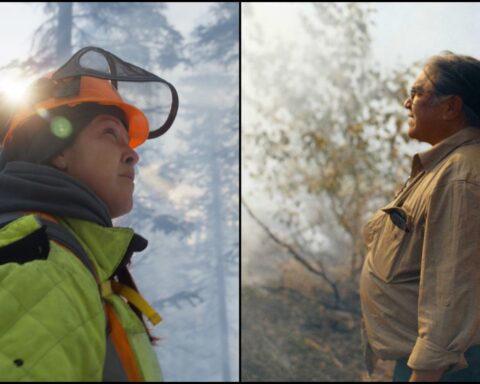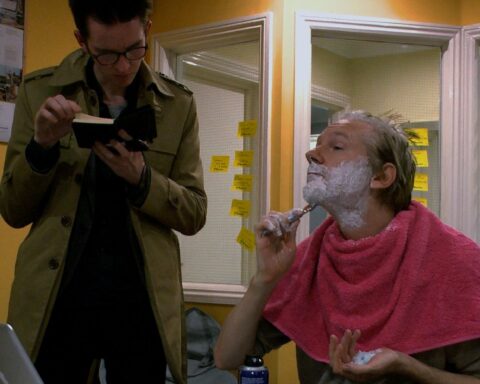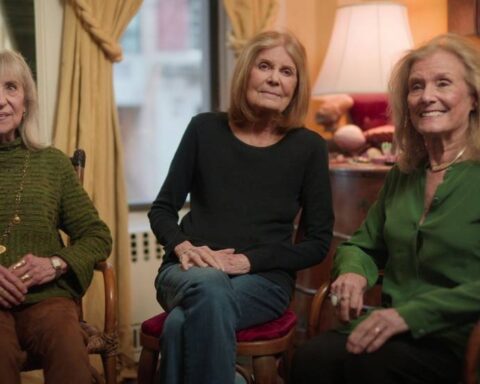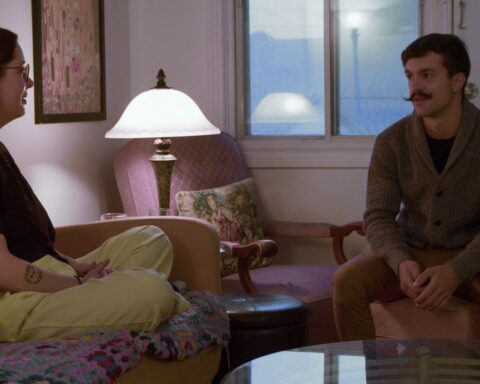The minute this article was fact-checked, the recorded interviews were erased.
“Cover your ass” was the basic message from Joe Berlinger, director of Crude: The Real Price of Oil, just 24 hours after he had been issued a U.S. federal appeals order in Manhattan (July 14) requiring him to surrender some of his 600 hours of outtakes to Chevron.
“My advice to anybody making a film about a controversial subject is: make your film, choose your DVD extras early, and dump your footage,” Berlinger told POV by phone from New York City.
This case is a monster. Crude itself chronicles a group of Ecuadorians who are suing Chevron—which now owns Texaco, the original target of the suit—saying that the company’s oilfield operations contaminated their drinking and bathing water.
Chevron, in turn, went after Crude ’s outtakes to seek “hidden evidence of corruption and misconduct captured by filmmaker Joe Berlinger,” (according to a May 24 news release) as part of its defence.
The company alleges that there is “direct evidence of fraud” in the pollution case against them, specifically via an Ecuadorian court-appointed environmental expert named Richard Cabrera, who appears in the film.
Cabrera also happens to be the man who headed up the independent environmental report, which says, “Chevron should pay US$27 billion in damages.”
Berlinger says he doesn’t think Chevron will find any “smoking gun” in the outtakes; but that wasn’t the point.
“It’s easy to point a finger [at oil companies] but that’s not what I’m fighting,” Berlinger said. “My position and my efforts have nothing to do with Chevron’s position in the underlying pollution lawsuit that is the subject of my film,” he continued. “I would be equally vociferous even if the subpoena came from the indigenous people of Ecuador who wanted to look at my footage to see what they could get against Chevron,” he said.
The court cases have left Berlinger understandably cautious about his documentary film work. “It’s opened my eyes to new dangers and precautions that must be taken,” he said. And reflecting on the outtakes that generally accumulate when a doc is being made, he advises filmmakers: “Everything you don’t use: get rid of it,” noting that such a practice is perfectly legal in America.
“You can do whatever you want as long as you haven’t been previously subpoenaed,” said the filmmaker like a tired warrior who has learned a valuable lesson while upholding his First Amendment rights to “journalist privilege.”
Yet even though he will have to hand over some of the 600 hours of outtakes to Chevron, he was glad the appeals court at least met the two standards of “piercing journalist’s privilege” which were set by the previous precedent case (known as Gonzalez v. NBC in 1999) and put the footage under protective order.
The two “piercing” standards dictate that the footage must be relevant to the specific issues in the underlying litigation and that the information in the footage cannot be reasonably acquired somewhere else. In addition, Berlinger also asked that the subpoenaed footage be put under a “protective order” so it could not be used for publicity or purposes other than the litigation in question.
The Manhattan appeals court “greatly limited the amount of footage which can be used, which is a victory in my eyes, and they asked that the footage be put under protective order,” Berlinger elaborated. “Those are two good things. Now, could it have been better and the categories more narrow? Yes,” he said, adding that he will obey the order, because he “respects the law.”
In two separate interviews—before and after the appeals hearing—Berlinger maintained that his legal battle was to ensure journalists and filmmakers could not be subjected to “general fishing expeditions” by large corporations with deep pockets that could ultimately undermine freedom of speech.
“If they [had been] successful in getting a reporter to turn entire files over to an interested party in a litigation, this [would] deter these kinds of films from being made in the future,” he said. “It [would] make editors think twice about putting anything controversial into stories, whether it’s for television or feature-length (documentary programmes), because we’d worry about the cost of being subpoenaed if we make it so easy for an interested party like Chevron.”
Handing over that much footage—without meeting the tough standards of “piercing journalist privilege”—would also have set a new precedent.
“I [was] arguing against the wholesale dumping onto their desk [of] my entire vault of footage. That’s an unjustified and deeply dangerous precedent. That would mean that anyone doing investigative reporting could be subject to their entire files being scoured by an interested party,” he said.
At press time, it was still unclear how much footage would be handed over to Chevron. “We are in the midst of editing the footage to remove any material the court has not ordered,” he explained.
Berlinger’s battle has been backed by virtually every major American media organization and a bevy of Hollywood’s elite.
A Friends of the Court brief was submitted by legendary First Amendment lawyer Floyd Abrams (an expert on constitutional law who has had many arguments adopted as United States Constitutional interpretative law as it relates to the First Amendment and free speech) on behalf of major U.S. news pillars, including the New York Times, the Washington Post, Associated Press, ABC, NBC/Universal, CBS, HBO and Dow Jones (although CNN was noticeably missing).
The filmmaker has backing from activist industry superstars such as Robert Redford, Leonardo DiCaprio, Woody Allen, Susan Sarandon, Morgan Spurlock (Super Size Me) and Louie Psihoyos (The Cove), not to mention the Academy of Motion Picture Arts and Sciences and the Directors Guild of America.
These people and organizations, however, do not cover legal bills.
Berlinger said the defence costs—at “the half-million-dollar mark, at this point”— have been covered in part by the filmmaker, in part by successful fundraisers, and that “a good portion of these bills” were also “covered by private individuals who are concerned about the First Amendment issues this case has raised.” He also noted that his law firm, Frankfurt Kurnit Klein and Selz, “has donated $100k in time.”
“The film about a David and Goliath story turned into a filmmaker’s David and Goliath story,” laughed Berlinger, whose sense of humour is still intact.
In other words, at the root of Chevron’s U.S. suit is the subject of Crude itself, an ongoing David and Goliath legal battle waged by 30,000 indigenous people against the fifth largest company on earth.
Their class action lawsuit (Aguinda v. Chevron) was originally filed in 1993 in America, but the case was transferred to Ecuador’s courts after Chevron won a round. It was initially filed against Texaco, but Chevron inherited the lawsuit when it bought Texaco in 2001.
The Lago Agrio plaintiffs continue to allege that Chevron polluted their water while drilling (from 1964 to 1990) for oil and should have to clean up the toxic mess, no matter how long it takes.
“To me, that’s the main theme of the film,” says Berlinger, “the disregard for indigenous populations that lived in harmony with nature for millennia.”
Berlinger himself spent three years (2005 to 2008) in that part of the Amazon rainforest documenting the polluted waters, the lives of the plaintiffs, the lawyers in charge of their case, various reps from Chevron, as well as members of the current Ecuadorian government. Some of Crude ’s subjects even imply that there may have been corruption in the former Ecuadorian government regime. And the film notes that state-owned Petroecuador became involved when Chevron pulled out of the South American country in 1992.
“One of the reasons that the destruction of the rainforest was possible in the first place was just kind of an attitude of a lack of respect for indigenous people,” Berlinger said. “That was classic throughout South America in the ’60s and ’70s; the ruling class elite are European-descended oligarchies that don’t necessarily care about their indigenous populations. I’m not saying that’s true now, but it’s part of the phenomena that allowed this thing to happen in the ’60s. Whether that was legal or not, that’s for somebody else to decide.”
The doc-maker is adamant that Crude explores all sides of this environmental catastrophe in a real journalistic way.
“My film is actually a very balanced film that presents all sides of a very complicated issue,” he said. Indeed.
Crude: The Real Price of Oil, premiered at Sundance in 2009 to raves and has since won 22 awards. It has garnered the world’s attention. The film has attracted many environmental groups who are closely following Chevron’s legal moves. Some of them allege that the First Amendment case was effectively just another delay tactic in the grand scheme of things.
The Amazon Defense Coalition (ADC) said in a statement: “We represent 30,000 people in the Amazon of Ecuador; their interests are distinct from those of film director Joe Berlinger.
“Because of Chevron’s reckless drilling practices and gross misconduct, the Amazon communities have suffered [for] almost 50 years from the horrific effects of an oil disaster that is far larger and worse than the BP spill on the Gulf Coast—both in the amount of oil spilled and in the direct impact on the people. Thousands have not only lost their livelihoods, but many have lost their lives to cancer and other oil-related diseases,” the statement continued.
The ADC alleges that the filmmaker was also used as part of an overall legal strategy to delay and divert.
“Chevron’s legal theatrics in New York are part of a larger strategy created to evade responsibility for creating the world’s worst and longest-lasting environmental catastrophe,” the statement said.
Why might Chevron want to draw this out, you ask?
Lawsuits can be expensive, especially ones that last a couple of decades in two countries.
The fact that the dirt-poor Lago Agrio people even have a lawyer is somewhat of a miracle in itself.
According to stories told by locals in Crude, the original plaintiff lawyer, Pablo Fajardo (who has since been joined by the American Harvard-trained attorney Steven Donziger) was put through an Ecuadorian law school at the expense of the Catholic church so he could defend his people—he has spent the better part of his adult life on this case.
Chevron, on the other hand, has no shortage of lawyers.
It is reportedly the fifth largest corporation in the world, the third largest in the U.S. (after Walmart and Exxon), and the biggest in California.
Chevron’s profit in fiscal 2009 was US$10.5 billion, according to a shareholders letter from John S. Watson, chair and CEO, posted on the investors section of its website.
“Total stockholder return—a critical measure of our performance—was No. 1 among our top competitors over the past five years. We increased our annual dividend in 2009 for the 22nd consecutive year. Net income in 2009 was $10.5 billion on sales and other operating revenues of $167 billion, reflecting lower prices from 2008 for crude oil and natural gas and lower sales margins and prices for refined products. Return on capital employed for the year was 10.6%,” Watson wrote.
The oil giant can afford lawyers to dodge the real case, according to Rainforest Foundation co-founder and filmmaker Trudie Styler in a statement posted on the blog “The Chevron Pit.”
“This latest action by Chevron [to obtain Berlinger’s outtakes] is part of a worldwide, desperate litigation campaign by the oil giant to escape liability for what is thought to be the world’s worst oil-related environmental catastrophe, she writes. “The extent of the contamination is almost unfathomable. By Chevron’s own admission they dumped at least 15.8 billion gallons of toxic ‘produced water’ in the region, and their own audits indicate that the number may actually be much higher—more than 18.5 billion gallons.”
It is alleged that the polluted area is the size of Rhode Island, or about 1,500 square miles.
Styler also appears in Crude, as her Rainforest Foundation (co-founded with husband Sting) was then setting up a temporary water purification system for the Amazon people affected.
“Though Chevron no longer operates in the area [having ceased Ecuadorian drilling operations in 1990], the pollution still remains,” Styler continues, adding that the pollution was no accident.
“Chevron’s dumping was, by the company’s own admission, a deliberate production decision to maximize profits,” she said.
And Chevron is quite profitable. On April 30, 2010, Chevron reported first-quarter earnings of US$4.55 billion (US$2.27 per share—diluted), more than double the US$1.84 billion earnings it reported in the first three months of its fiscal 2009.
So the battle continues, and it’s unclear when, where and if it will end, or even whether Berlinger’s film may have helped or hindered the rainforest people in question. The saga continues.
Chevron’s current legal angle appears to be about discrediting the plaintiffs’ witnesses, many of whom appear in Crude (and its outtakes).
Undermining the credibility of the “independent expert” is key to the current defence strategy; at least, that’s what is indicated in documents posted on its website.
The irony of course is that there is a slight possibility that Berlinger’s footage may eventually provide Chevron with the evidence it seeks.
“In his November 2008 damages report, Cabrera exclusively attributed pollution and associated impacts in Ecuador’s Amazon to Texaco Petroleum Company while absolving state-owned Petroecuador,” Chevron said, re-opening an issue also raised in _Crude_—that the Petroecuador company may share in the liability.
The Chevron document also raises the issue of fraud—a legal no-no that has seen many a case thrown out of court.
“This direct evidence of fraud…further demonstrates the illegitimacy of the fictitious $27-billion number the plaintiffs’ lawyers have created for the purpose of extracting money from Chevron and its shareholders,” Chevron vice president and general counsel Hewitt Pate said in the statement.
The victims in this case, Chevron alleges, are its shareholders.
You can see where this is headed. And it’s a monster case that could go on for many more years.
Nonetheless, the case within— Berlinger’s First Amendment showdown with Goliath—has provided some useful insight for filmmakers around the world. And his personal battle upheld the precarious two-pronged standards previously set to pierce journalist’s privilege in the almighty U.S., an important triumph in itself.
“I think that they did not anticipate that a little old documentary filmmaker would stand up for his First Amendment rights,” says Berlinger, with some sense of satisfaction.











